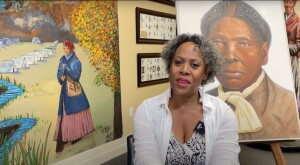As soon as my image leapt onto the videoconferencing screen, it dawned on me, a smiling African American woman wearing a sleek, multicolored headband, that I was probably a little too relaxed in my appearance. I also realized that my colleagues, mostly white and Asian, were seeing me for the first time in my natural, fuss-free cultural state.
In the classroom, I wear slacks or a skirt, a blouse, maybe a shawl. My hair is always neatly pulled back. I am prepared for that space. I have cultivated my image there over 18 years of university-level teaching — operating with the understanding that I am a role model by default. As such, I represent Black women and girls everywhere.
But in a virtual space, with just my cute smile, unruly locs and quickly typed questions in the chat box, I felt odd and spatially closer than I’d ever been to my colleagues. A little more exposed. A little more vulnerable. Zoom offered a window into our private spaces, and closing off mine, like some others had done, wasn’t an option. Whether due to my older hardware or my lack of Zoom savvy, I was unable to substitute a still profile picture for my live image or to hide my environment with a cute virtual background.
And right then Zoom was magnifying everything, including my long locs, which I had formed into eight large braids to shape them into waves. My headband wasn’t quite hiding their awkward thickness.
I noted that others were in T-shirts or sweaters. Waist down, they could have been in their pj’s for all we knew. Yet as hellos echoed and we waited for the team leader to join, I was uncomfortably aware that one of my braids kept sliding onto my shoulder like a black garden snake. I spent a few minutes in polite, uncomfortable silence, pushing it over my shoulder and out of the camera’s view, then I finally self-consciously laughed, saying, “I don’t want to deprive you all of my natural hair woes.” No one replied or laughed with me. Feeling like Issa Rae caught in the headlights, my agitation grew. Were my fellow Zoomers uncomfortable watching me and that damn braid?
In frustration, I muted my image, re-tucked the rogue braid, then un-muted my image. Unfortunately, I did this hair-tuck dance throughout the two-hour meeting. Midway through, one colleague thrust his adorable dog toward the camera lens. Trying to one-up him, another colleague took off his tennis shoe and presented it to us like a gift. I was stunned but willed my face into a mask. My colleagues seemed unconcerned with their own images, comfortable in this virtual space. In contrast, I am constantly aware of the race representation card in all executive gatherings: I would never have behaved as they did. When the meeting ended and I gratefully logged off, I realized that in our coronavirus climate, this was the new normal.
Many other Black women new to virtual meetings confront similar cultural nuances. Cassie,* who works for a government entity in California, shared with me what she had been thinking just before her first online staff meeting. “At the last minute,” she recalled, “I remembered to take my head wrap off. Even though we have the Crown Act [that prohibits workplace and school discrimination on the basis of hairstyle in a growing number of states], and while head wraps are acceptable in all-Black spaces, it wouldn’t have read that way in a multi-race space.”
With all-Black spaces come Wakanda head wraps, big jewelry and African print blouses that I, and other sisters, don’t always wear in the workplace. At home or among our own, Black women, Latinas and other women of color will likely sport hoop earrings, hijabs and colorful patterns that feel natural for us. These garments, accessories and symbols of culture and faith don’t make us any less intelligent, confident, essential or professional. But they often mark us as different in institutions where implicit bias is a reality.
Watching our faces in my Zoom meeting, I realized that not only had my colleagues better get used to locs, but they’d have to be ready for all kinds of nonconformity. More important, I had to get used to me, to seeing my ropelike locs in transparent cyberspace and resisting the urge to apologize for, or call unnecessary attention to, my hair or cultural attire. After all, if the dress code is “relaxed,” then I’m in compliance.
What happens when nonconformity swings the other way? While none of my coworkers called attention to my looks, Lena,* who works for a foundation, had an experience opposite mine. Opting to keep her professional image consistent, she joined a recent video meeting wearing the same business casual attire she wears to the office — a simple sleeveless blouse, small drop earrings and subtle lipstick. She sat in an uncluttered and well-lit corner of her house that revealed little of her lifestyle. Her white male development director, his jaw uncharacteristically shadowed with stubble and his golf shirt noticeably wrinkled, joked that she looked like a talk show guest. As the only minority on the call and the only one singled out for her appearance, she felt othered.
Cassie’s comment on how different groups “read” our appearance differently echoes my experience and Lena’s. But not all Black women feel self-conscious. Amelia,* who works for a city transportation agency, says “our department is very relaxed, so I’ll dress casually for online department meetings. However, because I’ll be at home, and I will have no problem wearing head scarves or my African attire. I don’t think it will be an issue. Our manager’s main concern is that we don’t meet in our pajamas.”
I admire her attitude.
The day after my first Zoom meeting, I logged onto another one, this time with mostly Black women professionals, educators, community health workers. Out of the 30 women, I counted six head scarves. Several wore perms or presses, but most wore braids or other naturally textured hairstyles. At the end, the team leader congratulated us on a great meeting and ended with, “Can I just say how much I love seeing all of y’all in this space with our head wraps and natural hair. Y’all look so beautiful.” We did. I took a screenshot because I was so proud. Several women clapped, and those of us with muted mics grinned and hoisted a thumbs-up in approval. In this private meeting, inaccessible to trolls (because racist "Zoombombing" of publicly shared meetings is a thing now, unfortunately) we felt safe.
Maybe space is the final frontier after all: virtual space. And if it is, then it’s not just for physical distancing during a pandemic. It might also be a liminal space beyond which we’ll explore art, expression, identity, self-policing, access, gender equality, race, office politics and, most definitely, the ways in which culture shapes imagination.
One thing is certain: We have no choice but to find out.
*Names have been changed.

Shannon Wright









